Abstract
The present study seeks to incorporate a highly variable DNA barcode marker, additional to the standard regions of the cytochrome oxidase I gene and the 3′ end of the 16S large ribosomal subunit (16S rRNA), for a more effective species-level identification among cephalopods. Thus, we evaluated whether the 5′ end region of the 16S rRNA gene can be suitable as a DNA barcode marker among these taxa. Using a novel primer set, 28 different species were evaluated based on the pairwise intra- and interspecific distance and neighbor-joining (NJ) analysis. Except for Enteroctopus dofleini, we were able to obtain the sequences for the remaining species which formed highly supported clusters in the NJ tree. Divergence at the interspecific level may indicate high genetic variation of the region being proposed as compared to the standard of 16S rRNA. In addition, two well-supported clades and high levels of divergence within Sthenoteuthis oualaniensis, Loliolus japonica and Sepia pharaonis suggest the occurrence of cryptic species. This study confirms the efficiency of the 5′ end region of the 16S rRNA gene as a DNA barcode marker which can be used along with the standard DNA markers in future studies.




Similar content being viewed by others
References
Allcock AL, Lindgren A, Strugnell JM (2014) The contribution of molecular data to our understanding of cephalopod evolution and systematics: a review. J Nat Hist 49:1–49
Caddy JF (1983) Advances in assessment of world cephalopod resources. FAO Fisheries Technical Paper, vol 231. FAO, Rome
Roper CFE, Sweeney MJ, Nauen CE (1984) Cephalopods of the world: an annotated and illustrated catalogue of species of interest to fisheries. FAO Species Catalogue for Fishery Purpose, vol 4. FAO, Rome
Zlatanos S, Laskaridis K, Feist C, Sagredos A (2006) Proximate composition, fatty acid analysis and protein digestibility-corrected amino acid score of three Mediterranean cephalopods. Mol Nutr Food Res 50:967–970
Iglesias J, Fuentes L, Villanueva R (2014) Cephalopod culture. Springer, Dordrecht
Galimberti A, De Mattia F, Losa A, Bruni LL, Federici S, Casiraghi M, Martellos S, Labra L (2013) DNA barcoding as a new tool for food traceability. Food Res Int 50:55–63
Boyle P, Rodhouse P (2006) Cephalopods: ecology and fisheries. Blackwell, Oxford
Boyle PR (1990) Cephalopod biology in the fisheries context. Fish Res 8:303–321
McKeown NJ, Robin J-P, Shaw PW (2015) Species-specific PCR–RFLP for identification of early life history stages of squid and other applications to fisheries research. Fish Res 167:207–209
Dai L, Zheng X, Kong L, Li Q (2012) DNA barcoding analysis of Coleoidea (Mollusca: Cephalopoda) from Chinese waters. Mol Ecol Resour 12:437–447
Anderson FE, Engelke R, Jarrett K, Valinassab T, Mohamed KS, Asokan PK, Zacharia PU, Nootmorn P, Chotiyaputta C, Dunning M (2010) Phylogeny of the Sepia Pharaonis species complex (cephalopoda: Sepiida) based on analyses of mitochondrial and nuclear DNA sequence data. J Molluscan Stud 77:65–75
Cheng SH, Anderson FE, Bergman A, Mahardika GN, Muchlisin ZA, Dang TB, Calumpong HP, Mohamed KS, Sasikumar G, Venkatesan V, Barber PH (2013) Molecular evidence for co-occurring cryptic lineages within the Sepioteuthis cf. lessoniana species complex in the Indian and Indo-West Pacific Oceans. Hydrobiologia 725:165–188
Staaf DJ, Ruiz-Cooley RI, Elliger C, Lebaric Z, Campos B, Markaida U, Gilly WF (2010) Ommastrephid squids Sthenoteuthis oualaniensis and Dosidicus gigas in the eastern Pacific show convergent biogeographic breaks but contrasting population structures. Mar Ecol Prog Ser 418:165–178
Hebert PDN, Ratnasingham S, de Waard JR (2003) Barcoding animal life: cytochrome c oxidase subunit 1 divergences among closely related species. Proc R Soc Lond B Biol Sci 270:S96–S99
Hebert PDN, Cywinska A, Ball SL, deWaard JR (2003) Biological identifications through DNA barcodes. Proc Biol Sci 270:313–321
Allcock AL, Barratt I, Eleaume M, Linse K, Norman MD, Smith PJ, Steinke D, Stevens DW, Strugnell JM (2011) Cryptic speciation and the circumpolarity debate: a case study on endemic Southern Ocean octopuses using the COI barcode of life. Deep Sea Res Part II Top Stud Oceanogr 58:242–249
Kaneko N, Kubodera T, Iguchis A (2011) Taxonomic study of shallow-water octopuses (Cephalopoda: Octopodidae) in Japan and adjacent waters using mitochondrial genes with perspectives on octopus DNA barcoding. Malacologia 54:97–108
Williams RC, Newman SJ, Sinclair W (2012) DNA barcoding in Nautilus pompilius (Mollusca: Cephalopoda): evolutionary divergence of an ancient species in modern times. Invertebr Syst 26:548–560
Wakabayashi T, Suzuki N, Sakai M, Ichii T, Chow S (2006) Identification of ommastrephid squid paralarvae collected in northern Hawaiian waters and phylogenetic implications for the family Ommastrephidae using mtDNA analysis. Fish Sci 72:494–502
Taylor AL, McKeown NJ, Shaw PW (2012) Molecular identification of three co-occurring and easily misidentified octopus species using PCR–RFLP techniques. Conserv Genet Resour 4:885–887
Strugnell JM, Lindgren AR (2007) A barcode of life database for the Cephalopoda? considerations and concerns. Rev Fish Biol Fish 17:337–344
Cheng R, Zheng X, Ma Y, Li Q (2013) The complete mitochondrial genomes of two octopods Cistopus chinensis and Cistopus taiwanicus: revealing the phylogenetic position of the genus Cistopus within the order Octopoda. PLoS ONE 8:e84216
Chapela MJ, Sotelo CG, Calo-Mata P, Perez-Martin RI, Rehbein H, Hold GL, Quinteiro J, Rey-Mendez M, Rosa C, Santos AT (2002) Identification of cephalopod species (Ommastrephidae and Loliginidae) in seafood products by Forensically Informative Nucleotide Sequencing (FINS). J Food Sci 67:1672–1676
Palumbi S, Martin A, Romano S, Mcmillan WO, Stice L, Grabowski G (1991) The simple fool’s guide to PCR, version 20. University of Hawaii Press, Honolulu
Marín A, Fujimoto T, Arai K (2014) The variable 5′ end of the 16S rRNA gene as a novel barcoding tool for scallops (Bivalvia, Pectinidae). Fish Sci 81:73–81
Tautz D, Arctander P, Minelli A, Thomas RH, Vogler AP (2003) A plea for DNA taxonomy. Trends Ecol Evol 18:70–74
Okutani T (2015) Cuttlefish and squid of the world. Seizando-Shoten Publishing, Tokyo
Yoshida M, Tsuneki K, Furuya H (2006) Phylogeny of selected Sepiidae (Mollusca, Cephalopoda) based on 12S, 16S, and COI sequences, with comments on the taxonomic reliability of several morphological characters. Zool Sci 23:341–351
Jereb P, Roper C (2010) Cephalopods of the world. An annotated and illustrated catalogue of cephalopod species known to date, vol 2. Myopsid and Oegopsid Squids. FAO Species Catalogue for Fishery Purpose. No. 4. FAO, Rome
Jereb P, Roper CFE, Norman MD, Julian KF (2014) Cephalopods of the world. An annotated and illustrated catalogue of cephalopod species known to date, vol 3. Octopods and Vampire Squids. FAO Species Catalogue for Fishery Purpose. No. 4. FAO, Rome
Tomano S, Ueta Y, Kasaoka N, Umino T (2015) Stock identification and spawning depth of oval squid Sepioteuthis spp. in Tanega-shima Island inferred by DNA markers. Acuacult Sci 63:39–47 (In Japanese with English abstract)
Izuka T, Numachi K, Segawa S, Okutani T (1994) Evidence on the existence of three species in the oval squid, Sepioteuthis lessoniana complex in Ishigaki Island, Okinawa, south-western Japan, by isozyme analyses. Jpn J Malacol Venus 53:217–228
Katoh K, Standley DM (2013) MAFFT multiple sequence alignment software version 7: improvements in performance and usability. Mol Biol Evol 30:772–780
Librado P, Rozas J (2009) DnaSP v5: a software for comprehensive analysis of DNA polymorphism data. Bioinformatics 25:1451–1452
Asahida T, Kobayashi T, Saitoh K, Nakayama I (1996) Tissue preservation and total DNA extraction form fish stored at ambient temperature using buffers containing high concentration of urea. Fish Sci 62:727–730
Tamura K, Stecher G, Peterson D, Filipski A, Kumar S (2013) MEGA6: molecular evolutionary genetics analysis version 6.0. Mol Biol Evol 30:2725–2729
Kimura M (1980) A simple method for estimating evolutionary rates of base substitutions through comparative studies of nucleotide sequences. J Mol Evol 16:111–120
Saitou N, Nei M (1987) The neighbor-joining method: a new method for reconstructing phylogenetic trees. Mol Biol Evol 4:406–425
Iserte JA, Stephan BI, Goñi SE, Borio CS, Ghiringhelli PD, Lozano ME (2013) Family-specific degenerate primer design: a tool to design consensus degenerated oligonucleotides. Biotechnol Res Int 2013:383646. doi:10.1155/2013/383646
Lutzoni F, Wagner P, Reeb V, Zoller S (2000) Integrating ambiguously aligned regions of DNA sequences in phylogenetic analyses without violating positional homology. Syst Biol 49:628–651
Noé L, Kucherov G (2004) Improved hit criteria for DNA local alignment. BMC Bioinform 5:149
Chu KH, Li CP, Qi J (2006) Ribosomal RNA as molecular barcodes: a simple correlation analysis without sequence alignment. Bioinformatics 22:1690–1701
Lemey P, Salemi M, Vandamme A-M (2009) The Phylogenetic Handbook: a practical approach to phylogenetic analysis and hypothesis testing, 2nd edn. Cambridge University Press, Cambridge
Thompson JD, Higgins DG, Gibson TJ (1994) CLUSTAL W: improving the sensitivity of progressive multiple sequence alignment through sequence weighting, position-specific gap penalties and weight matrix choice. Nucleic Acids Res 22:4673–4680
Edgar RC (2004) MUSCLE: multiple sequence alignment with high accuracy and high throughput. Nucleic Acids Res 32:1792–1797
Lydeard C, Holznagel WE, Schnare MN, Gutell RR (2000) Phylogenetic analysis of molluscan mitochondrial LSU rDNA sequences and secondary structures. Mol Phylogenet Evol 15:83–102
Layton KKS, Martel AL, Hebert PD (2014) Patterns of DNA barcode variation in Canadian marine molluscs. PLoS ONE 9:e95003
Nesis KN (1993) Population structure of oceanic ommastrephids, with particular reference to Sthenoteuthis oualaniensis: a review. In: Okutani T, O’Dor RK, Kubodera T (eds) Recent advances in cephalopod fishery biology. Tokai University Press, Tokyo, pp 375–383
Xinjun C, Bilin L, Siquan T, Weiguo Q, Xiaohu Z (2007) Fishery biology of purpleback squid, Sthenoteuthis oualaniensis, in the northwest Indian Ocean. Fish Res 83:98–104
Fang Z, Xu L, Chen X, Liu B, Li J, Chen Y (2015) Beak growth pattern of purpleback flying squid Sthenoteuthis oualaniensis in the eastern tropical Pacific equatorial waters. Fish Sci 81:443–452
Vecchione M, Shea E, Bussarawit S, Anderson F, Alexeyev D, Lu C-C, Okutani T, Roeleveld M, Chotiyaputta C, Roper C, Jorgensen E, Sukramongkol N (2005) Systematics of Indo-West Pacific Loliginids. Phuket Mar Biol Cent Res Bull 66:23–26
Vecchione M, Brakoniecki TF, Natsukari Y, Hanlon RT (1998) A provisional generic classification of the family loliginidae. Smithson Contrib Zool 586:215–222
Kawashima Y, Nishihara H, Akasaki T, Nikaido M, Tsuchiya K, Segawa S, Okada N (2013) The complete mitochondrial genomes of deep-sea squid (Bathyteuthis abyssicola), bob-tail squid (Semirossia patagonica) and four giant cuttlefish (Sepia apama, S. latimanus, S. lycidas and S. pharaonis), and their application to the phylogenetic analysis of Decapodiformes. Mol Phylogenet Evol 69:980–993
Wang W, Guo B, Li J, Qi P, Wu C (2014) Complete mitochondrial genome of the common cuttlefish Sepia pharaonis (Sepioidea, Sepiidae). Mitochondrial DNA 25:198–199
Acknowledgments
This research was partly supported by “Grants-in-Aid for Scientific Research” (no. 26292106 for T.U.) and a “Graduate Student Scholarship for Foreign Student”, both from the Japanese Government through the Ministry of Education, Culture, Sport, Science and Technology in Japan (Monbukagakusho: MEXT). We are also grateful to the following professors who kindly provided samples for this study: Dr. Taeko Miyazaki of Mie University with Sepioteuthis sp. 3, Dr. Ian G. Gleadall of Tohoku University with Opisthoteuthis sp. and Dr. John Bower of Hokkaido University with E. dofleini. We wish to thank Miyajima Aquarium (Hiroshima Prefecture) for providing samples of A. dux and Toba Aquarium (Mie Prefecture) for the samples of Nautilus macromphalus and Nautilus pompilius. We also wish to thank to Li Qiang and Dr. Zhizhi Liu from Shanghai Ocean University for providing samples of Uroteuthis chinensis, Atsushi Tsuyuki from Hiroshima University for his support during the sample collection in Japan, Dr. Lawrence Liao from Hiroshima University and his student Dan Anthony Uy Bataan from the Philippines for the great help with the collection of samples in their country. Finally, the authors gratefully acknowledge the criticism of two anonymous reviewers who greatly improved the manuscript.
Author information
Authors and Affiliations
Corresponding author
Electronic supplementary material
Below is the link to the electronic supplementary material.
Rights and permissions
About this article
Cite this article
Sanchez, G., Tomano, S., Umino, T. et al. Evaluation of the 5′ end of the 16S rRNA gene as a DNA barcode marker for the Cephalopoda. Fish Sci 82, 279–288 (2016). https://doi.org/10.1007/s12562-015-0962-8
Received:
Accepted:
Published:
Issue Date:
DOI: https://doi.org/10.1007/s12562-015-0962-8




